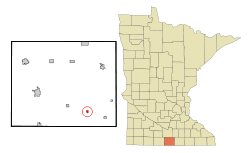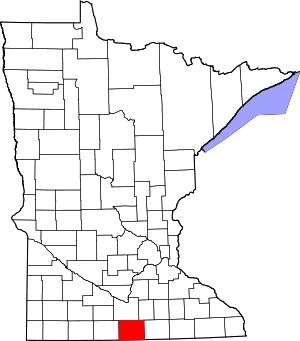Bricelyn, Minnesota
Bricelyn is a city in Faribault County, Minnesota, United States. The population was 365 at the 2010 census.[7]
Bricelyn | |
|---|---|
| Motto(s): "A Good Place To Call Home"[1] | |
 Location of Bricelyn, Minnesota | |
| Coordinates: 43°33′38″N 93°48′43″W | |
| Country | United States |
| State | Minnesota |
| County | Faribault |
| Government | |
| • Type | Mayor - Council |
| • Mayor | Thomas Sens |
| Area | |
| • Total | 0.29 sq mi (0.75 km2) |
| • Land | 0.29 sq mi (0.75 km2) |
| • Water | 0.00 sq mi (0.00 km2) |
| Elevation | 1,181 ft (360 m) |
| Population | |
| • Total | 365 |
| • Estimate (2019)[4] | 337 |
| • Density | 1,162.07/sq mi (447.96/km2) |
| Time zone | UTC-6 (Central (CST)) |
| • Summer (DST) | UTC-5 (CDT) |
| ZIP code | 56014 |
| Area code(s) | 507 |
| FIPS code | 27-07678[5] |
| GNIS feature ID | 0640470[6] |
| Website | http://www.co.faribault.mn.us/Bricelyn/ |
History
The town developed as a result of the railroad coming through the area. In 1899 town lots were auctioned.[1] The city was named for John Brice, the original owner of the town site.[8] A post office has been in operation at Bricelyn since 1899.[9]
Geography
According to the United States Census Bureau, the city has a total area of 0.29 square miles (0.75 km2), all of it land.[10]
Demographics
| Historical population | |||
|---|---|---|---|
| Census | Pop. | %± | |
| 1900 | 166 | — | |
| 1910 | 352 | 112.0% | |
| 1920 | 564 | 60.2% | |
| 1930 | 509 | −9.8% | |
| 1940 | 601 | 18.1% | |
| 1950 | 639 | 6.3% | |
| 1960 | 542 | −15.2% | |
| 1970 | 470 | −13.3% | |
| 1980 | 487 | 3.6% | |
| 1990 | 426 | −12.5% | |
| 2000 | 379 | −11.0% | |
| 2010 | 365 | −3.7% | |
| Est. 2019 | 337 | [4] | −7.7% |
| U.S. Decennial Census[11] | |||
2010 census
As of the census[3] of 2010, there were 365 people, 168 households, and 97 families living in the city. The population density was 1,258.6 inhabitants per square mile (485.9/km2). There were 197 housing units at an average density of 679.3 per square mile (262.3/km2). The racial makeup of the city was 92.6% White, 2.5% African American, 1.4% Native American, 0.8% Asian, 0.5% from other races, and 2.2% from two or more races. Hispanic or Latino of any race were 9.6% of the population.
There were 168 households, of which 21.4% had children under the age of 18 living with them, 44.6% were married couples living together, 8.9% had a female householder with no husband present, 4.2% had a male householder with no wife present, and 42.3% were non-families. 38.7% of all households were made up of individuals, and 16.7% had someone living alone who was 65 years of age or older. The average household size was 2.17 and the average family size was 2.89.
The median age in the city was 47.9 years. 22.5% of residents were under the age of 18; 6.5% were between the ages of 18 and 24; 18.6% were from 25 to 44; 27.4% were from 45 to 64; and 24.9% were 65 years of age or older. The gender makeup of the city was 52.1% male and 47.9% female.
2000 census
As of the census of 2000, there were 379 people, 182 households, and 101 families living in the city. The population density was 1,283.9 people per square mile (487.8/km2). There were 208 housing units at an average density of 704.6 per square mile (267.7/km2). The racial makeup of the city was 99.47% White, 0.26% from other races, and 0.26% from two or more races. Hispanic or Latino of any race were 3.96% of the population.
There were 182 households, out of which 21.4% had children under the age of 18 living with them, 49.5% were married couples living together, 2.2% had a female householder with no husband present, and 44.0% were non-families. 39.6% of all households were made up of individuals, and 20.3% had someone living alone who was 65 years of age or older. The average household size was 2.08 and the average family size was 2.80.
In the city, the population was spread out, with 20.8% under the age of 18, 5.8% from 18 to 24, 22.4% from 25 to 44, 23.7% from 45 to 64, and 27.2% who were 65 years of age or older. The median age was 46 years. For every 100 females, there were 102.7 males. For every 100 females age 18 and over, there were 106.9 males.
The median income for a household in the city was $29,375, and the median income for a family was $39,375. Males had a median income of $31,354 versus $21,111 for females. The per capita income for the city was $15,340. About 7.5% of families and 10.2% of the population were below the poverty line, including 7.5% of those under age 18 and 10.5% of those age 65 or over.
References
- "The City of Bricelyn Minnesota". The City of Bricelyn Minnesota. Archived from the original on January 18, 2012. Retrieved October 14, 2012.
- "2019 U.S. Gazetteer Files". United States Census Bureau. Retrieved July 26, 2020.
- "U.S. Census website". United States Census Bureau. Retrieved 2012-11-13.
- "Population and Housing Unit Estimates". United States Census Bureau. May 24, 2020. Retrieved May 27, 2020.
- "U.S. Census website". United States Census Bureau. Retrieved 2008-01-31.
- "US Board on Geographic Names". United States Geological Survey. 2007-10-25. Retrieved 2008-01-31.
- "2010 Census Redistricting Data (Public Law 94-171) Summary File". American FactFinder. United States Census Bureau. Retrieved 27 April 2011.
- Chicago and North Western Railway Company (1908). A History of the Origin of the Place Names Connected with the Chicago & North Western and Chicago, St. Paul, Minneapolis & Omaha Railways. p. 46.
- "Faribault County". Jim Forte Postal History. Retrieved 29 May 2015.
- "US Gazetteer files 2010". United States Census Bureau. Archived from the original on 2012-01-25. Retrieved 2012-11-13.
- "Census of Population and Housing". Census.gov. Retrieved June 4, 2015.
